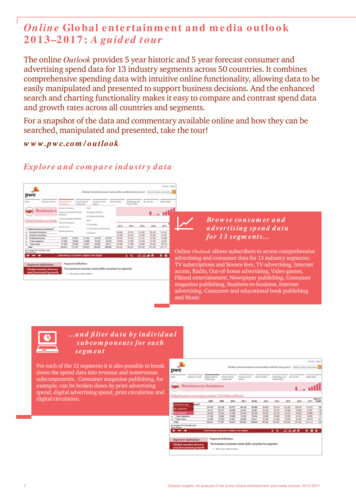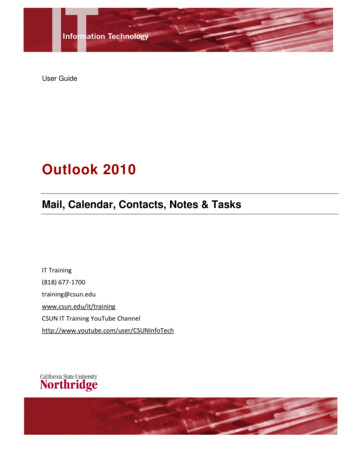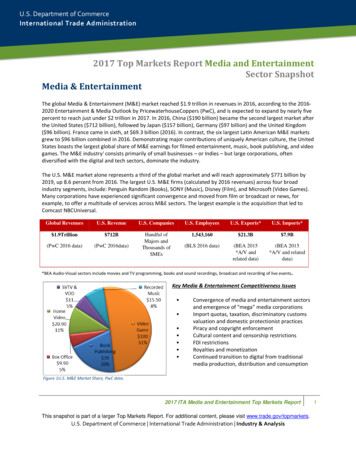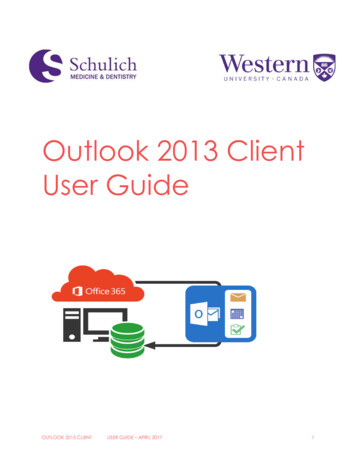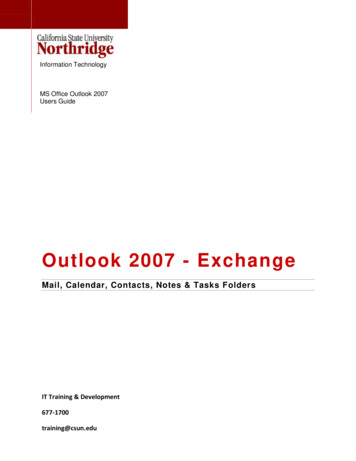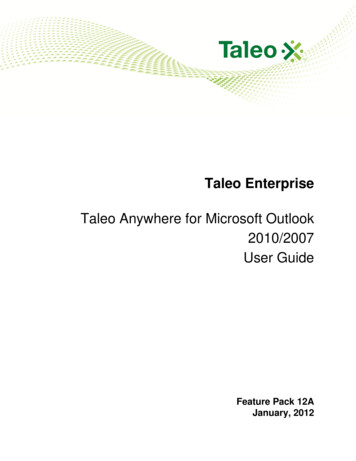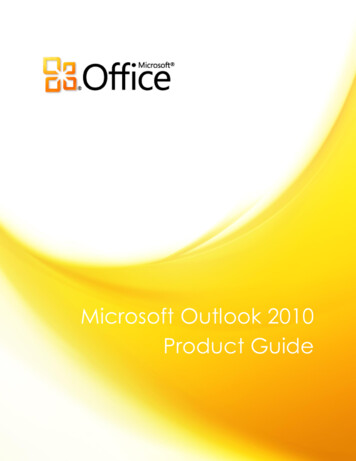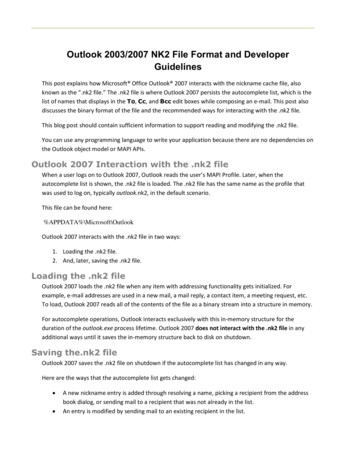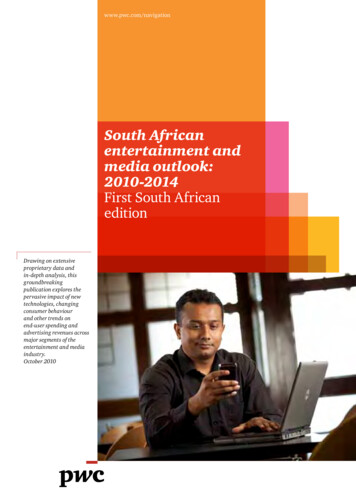
Transcription
www.pwc.com/navigationSouth Africanentertainment andmedia outlook:2010-2014First South AfricaneditionDrawing on extensiveproprietary data andin-depth analysis, thisgroundbreakingpublication explores thepervasive impact of newtechnologies, changingconsumer behaviourand other trends onend-user spending andadvertising revenues acrossmajor segments of theentertainment and mediaindustry.October 2010
2010 Published in South Africa by PricewaterhouseCoopers. All rights reserved.“PwC” is the brand under which member firms of PricewaterhouseCoopers International Limited(PwCIL) operate and provide services. Together, these firms form the PwC network. Each firm inthe network is a separate legal entity and does not act as agent of PwCIL or any other member firm.PwCIL does not provide any services to clients. PwCIL is not responsible or liable for the acts oromissions of any of its member firms nor can it control the exercise of their professional judgment orbind them in any way.
South African entertainmentand media outlook: 2010-2014First South African editionFollowing a steep economic decline in2009 and the windfall of the 2010 FIFAWorld Cup, this publication provides anoverview of how the entertainment andmedia industry in South Africa will developover the coming years. Focusing on 12major industry segments, it details thekey trends observed and challenges facingindustry segments as well as consideringtheir future prospects.South African entertainment and mediaoutlook: 2010-2014 combines deepknowledge of the local market with atruly global perspective and is a powerfultool for understanding critical businessissues. To learn more about the challengesand opportunities that lie ahead for theentertainment and media industry in SouthAfrica, please visit www.pwc.com/za.About PricewaterhouseCoopers’Entertainment and Media industrygroupEvery day, PricewaterhouseCoopers(PwC) plays a significant supportingrole in entertainment and media (E&M)businesses across the world. With ourglobal outlook and local knowledge ofculture, laws and business needs, we helpclients in South Africa and elsewhere makethe most of changing market scenarios.We understand how development in thebroader E&M environment is affectingour clients and work with them as atrusted advisor to provide solutions tohelp improve organisational effectivenessand long-term success. More significantly,we focus on the issues and challengesthat are of utmost importance to ourclients. These include restructuring,talent management, changing revenuemodels, intellectual property and rightsmanagement, compliance and managingcapital spend. We have made a substantialcommitment to understanding the forcesthat are impacting these issues – suchas wireless and digital distribution andtechnologies – and continue to develop anddeliver solutions to help our clients achievetheir financial, operational and strategicobjectives.
Prepared and edited by:PricewaterhouseCoopers (PwC), whichprovides industry-focused assurance, taxand advisory services to enhance valuefor its clients. More than 163,000 peoplein 151 countries in firms across the PwCnetwork share their thinking, experienceand solutions to develop fresh perspectivesand practical advice.PricewaterhouseCoopers Inc.2 Eglin RoadSunninghill, 2157 27 11 797 4000www.pwc.com/zaConsumer insightsIn developing this publication, we aimed to provide readers with useful informationand to bring this to life by including real-life consumer insights. To this end, wecontracted GlobalEdge Marketing Consultants to perform consumer lifestyleresearch relating to the media and entertainment industry.This research comprised face-to-face interviews with a sample of consumers thatincluded a mix of the following demographic groups:Market research Persons between the ages of 15 and 50;Quantitative research and analysis wasprovided by Wilkofsky Gruen AssociatesInc., a provider of global research andanalysis of the media, entertainment andtelecommunications industries. See www.wilkofskygruen.com for more information. A mix of racial groups;David Wilkofsky, PartnerArthur Gruen, PartnerEditorial team Vicki Myburgh, Southern AfricanEntertainment and Media IndustryLeader Craig Napier, Associate Director Sunet Liebenberg, Senior Manager Elenor Smith, Assistant Manager Louis de Jager, Assistant ManagerEditing and design Catherine Ensor Jackii EsterhuizenAdministration Carol RochfortMany other professionals within PwCand external to PwC have reviewedthe text and contributed localexpertise to this publication and wethank them for their assistance. Males and females; Residing in Gauteng, the Western Cape and KwaZulu-Natal; and LSM 5-7 and LSM 8-10.The results of this research have been utilised throughout this publication.Use of Outlook dataThe information contained in this publication is provided for general informationpurposes only, and does not constitute the provision of legal or professional advice in anyway. Before making any decision or taking any action, a professional advisor should beconsulted. No responsibility for loss to any person acting or refraining from action as aresult of any material in this publication can be accepted by the author, copyright owneror publisher.The information in this document is provided “as is” with no assurance or guarantee ofcompleteness, accuracy or timeliness of the information, and without warranty of anykind. In no event will PricewaterhouseCoopers be liable for any losses arising from anydecision made or action taken in reliance on the information.Designations used by companies to distinguish their products are often claimed astrademarks. In all instances where PricewaterhouseCoopers is aware of a claim, theproduct names appear in initial capital letters or all capital letters. Readers, however,should contact those companies for more complete information regarding trademarks andregistration.Permission to citeNo part of this publication may be excerpted, reproduced, stored in a retrieval system,or distributed or transmitted in any form or by any means including electronic,mechanical, photocopying, recording, or scanning without the prior written permission ofPricewaterhouseCoopers.Requests should be submitted in writing to Vicki Myburgh at vicky.myburgh@za.pwc.com outlining the excerpts you wish to use along with a draft copy of the full reportthat excerpts will appear in. Provision of this information is necessary for every citationrequest to enable PricewaterhouseCoopers to assess the context in which the excerpts arebeing presented.
Table of contentsContacts6Chapter 1 – Industry overview8Chapter 2 – InternetConsumer insights: InternetChapter 3 –Television183340Consumer insights: Television52Chapter 4 – Filmed entertainment56Consumer insights: Filmed entertainmentChapter 5 – Radio6468Consumer insights: Radio75Chapter 6 – Recorded music80Chapter 7 – Consumer magazine publishing90Chapter 8 – Newspaper publishing100Chapter 9 – Consumer and educational book publishing110Chapter 10 – Business-to-business publishing122Chapter 11 – Out-of-home advertising134Chapter 12 – Video games140Consumer insights: Video games153Chapter 13 – Sports160Glossary of terms170
ContactsPwC South AfricaEntertainment and Media industry group contactsTechnology, Information, Communications and EntertainmentIndustry Leader (TICE) – AfricaBerno Niebuhrberno.niebuhr@za.pwc.com 27 12 429 0050Entertainment and Media Leader – Southern AfricaVicki Myburghvicky.myburgh@za.pwc.com 27 11 797 4305Assurance servicesVicki Myburghvicky.myburgh@za.pwc.com 27 11 797 4305Advisory servicesMarthie Craffordmarthie.crafford@za.pwc.com 27 12 429 0511Taxation servicesWicus Coetzerwicus.coetzer@za.pwc.com 27 11 797 4177Corporate financeJan Groenewaldjan.groenewald@za.pwc.com 27 11 797 5380Transaction servicesPeter McCrystalpeter.mccrystal@za.pwc.com 27 11 797 52756 South African entertainment and media outlook: 2010-2014
Ignatius Sehoole, DirectorLeader – Markets andIndustries, PwC SouthernAfricaVicki Myburgh, DirectorLeader – Entertainment& Media, PwC SouthernAfricaJohannesburg14 October 2010To our clients and friends both in and beyond the entertainment and media industry:Welcome to South African entertainment and media outlook: 2010-2014, the first publication inPricewaterhouseCoopers’ South African Media outlook series. The forecasts and analysis in this publication focus ontwelve major entertainment and media (E&M) industry segments. Each chapter details the key trends observed andchallenges facing industry segments as well as considering their future prospects. The ‘Industry overview’ sectionhighlights the notable themes observed during 2009 and provides an informed perspective on industry trends in thecoming years.In 2009, the global recession severely impacted economic activity, translating into steep declines in advertising as well asconsumer spending. As the E&M industry begins to recover from the economic downturn, the resilience of E&M productsand services during the recession is evident. Meanwhile, the overall advertising market is undergoing a structuralresizing brought about by the Internet, as consumers and advertisers migrate online.Total South African E&M spending grew by 1.8% in 2009, in contrast to the 1.8% decline globally, but this is down fromthe 8.5% growth seen in 2008.Across the world, it is evident that the speed with which consumers are transitioning to digital has been acceleratingbeyond the industry’s expectations. In South Africa, while the spend on digital media is expected to grow significantly, itis unlikely that it will dominate in the forecast period. Non-digital revenue streams are expected to continue to be muchlarger and will still account for 69.1% of total South African spending in 2014. This suggests that the way forward forE&M companies lies in using digital technologies to generate revenues from ongoing changes in consumer behaviour,while also maintaining and supporting their non-digital offerings as a valuable source of cash and customers.We at PricewaterhouseCoopers continue to stay on top of trends and developments that may impact E&M companies,now and in the future, and we look forward to further sharing our thoughts with you. We appreciate your feedback andask that you continue to tell us what we can do to make our publications more relevant and useful to you.If you would like further clarification on any matters covered in this publication, or you believe we can be of service toyour business in any way, please contact one of our E&M specialists listed on page 6 of this report.Finally, we thank you for your support and wish you an exciting and rewarding year ahead.Sincerely,Ignatius SehooleVicki MyburghSouth African entertainment and media outlook: 2010-2014 7
Chapter 1Industry overview – South African entertainment andmedia outlook: 2010-20148 South African entertainment and media outlook: 2010-2014
We are pleased to present the first edition ofPricewaterhouseCoopers’ South African entertainmentand media outlook: 2010-2014 (the Outlook).The information in this publication brings together the collective knowledge of ourteam of professionals who work with entertainment and media (E&M) companies inSouth Africa and globally. We believe that this is a unique resource for the industry,offering a five-year outlook for consumer spending and advertising revenues in SouthAfrica and globally, as well as insights into the technology, legislative, political andbusiness trends driving these forecasts. The purpose of this overview is to providea synopsis of the data presented in the other 12 chapters of this publication and topresent an analysis of some of the most significant themes and insights generated bythe data in the various chapters.The Outlook presents annual historicaldata for 2005-2009 and provides annualforecasts for 2010-2014 in the following 12entertainment and media segments: Internet Television Filmed entertainment Radio Recorded music Consumer magazine publishing Newspaper publishing Consumer and educational bookpublishing Business-to-business publishing Out-of-home advertising Video games Sports2009: A year to remember?With some notable exceptions, the severerecession in most countries led to steepdeclines globally in advertising, thecategory most sensitive to the economyand to reductions in consumer/enduser spending. Global advertising fell by11.8% and consumer/end-user spendingdecreased by 0.5%. As a whole, the globalE&M market declined by 3.0% in 2009.In South Africa, while not as severelyaffected by the global recession as someother countries, the E&M industry grew by1.8% in 2009, down from the 8.5% growthin 2008 and the double-digit annual gainsduring the three years preceding 2008.Advertising, which is more sensitive tocyclical trends than end-user spending,fell by 14.3% as the full effect of therecession was felt in 2009. Consumer/end-user spending, which comprised 69%of the total market in 2009, countered theeffects of the recession with a boomingbox office market, continued growth inTV subscription spending and a jump inbroadband spending. Growth actuallyincreased to 11.1% from 8.8% in 2008.The growth in consumer/end-userspending was led by broadband andmobile Internet access, which boostedInternet access spending by 29.8%.Television subscriber numbers increasedby 17.4%, which fueled a 20% increase insubscription spending.South African entertainment and media outlook: 2010-2014 9
Entertainment and media spending (R millions)South AfricaAdvertising% changeEnd-user spending% changeTotal% AGR8.110.49.7Sources: PricewaterhouseCoopers LLP, Wilkofsky Gruen AssociatesThe economyEntertainment and media spending (R billions)While industry-specific factors will affectthe spending pattern for each segmentduring the next five years, the economiccycle will be an important driver. In 2009,South Africa experienced its first recessionin years, although it appears to be on thepath to recovery in wth in real GDP, which is adjusted forinflation, slowed to 3.7% in 2008 fromgains in excess of 5% annually during2005-07, and then fell by 1.8% in 2009.We expect a 4.5% rebound in 2010 and areturn to growth of 5% or more during thesubsequent four years. Overall, real GDPgrowth will average 5.1% compoundedannually during the next five years.2014End-user spendingAdvertisingSources: PricewaterhouseCoopers LLP, Wilkofsky Gruen AssociatesOn a segmental basis, the Internet wasthe fastest-growing segment in 2009with a 29.8% increase, boosted by asurge in broadband growth and doubledigit increases in advertising, the onlysignificant advertising category to grow in2009.Video games was next at 13.4%, followedby filmed entertainment at 11.7%. Doubledigit growth in each component offset aflat PC games market and propelled overallvideo games spending while a strong boxoffice market drove filmed entertainment.Inflation propelled nominal GDP at doubledigit rates during 2005-08 and kept theeconomy growing in nominal terms in2009 with a 4.8% increase despite thedecrease in real GDP. As real GDP beganexpanding in 2010, we project a returnto double-digit growth in nominal GDPduring the next five years. We expectnominal GDP growth to average 11.6% ona compound annual basis through 2014.Sports revenues increased by 5.8% in2009 as new tournaments and a strongsponsorship and merchandising marketoffset the absence of spending associatedwith the Beijing Olympics in 2008.GDP growth (%)South AfricaReal GDP growthNominal GDP 4.814.34.811.011.512.012.011.511.6Source: Statistics South Africa, World Bank, PricewaterhouseCoopers LLP, Wilkofsky Gruen Associates10 South African entertainment and media outlook: 2010-2014
E&M growth versus GDP growth (%)Except for the disproportionate impactof the 2010 FIFA World Cup, we expectthe general pattern in nominal GDP tobe reflected in the general pattern forentertainment and media growth.2520151050-5-102005200620072008Nominal E&M growth2009201020112012Nominal GDP growth20132014Real GDP growthSources: Statistics Africa, World Bank, PricewaterhouseCoopers LLP, Wilkofsky GruenAssociatesDigital share of E&M spending 9.82005 2006 2007 2008 2009 2010 2011 2012 2013 2014Sources PricewaterhouseCoopers LLP, Wilkofsky Gruen Associates2502001501005002005 2006 2007 2008 2009 2010 2011 2012 2013 2014DigitalNondigitalSources PricewaterhouseCoopers LLP, Wilkofsky Gruen AssociatesIn addition to the impact of the economy,the E&M market in South Africa continuedto migrate to digital formats. In 2009,digital accounted for 14.6% of spending,up from 9.8% in 2008. We expect thedigital market to constitute 30.9% of totalspending by 2014.Nondigital spending began declining in2009 and while the economic recoverywill help the nondigital components of themarket, nondigital spending growth willremain modest and digital will continue tobe the principal driver.Note: Digital spending consists of broadbandand mobile access; wired and mobile Internetadvertising; online and mobile TV advertising;digital recorded music distribution; digitaldownloads; online and wireless video games;digital advertising in newspapers and consumermagazines; online radio advertising; electronicconsumer and educational and professional books;digital directory advertising and trade magazinedigital advertising.Digital and nondigital spending growth (%)-50The 2010 FIFA World Cup will provide alarge boost in 2010 and the absence of thatspending will lead to a large decline in2011. The economy in these years will haveless of an impact than it has had in the past.We then look for entertainment and mediaspending to closely track nominal GDPgrowth during 2012-14.2014: South AfricanoutlookTotal South African E&M spending in 2014will total an estimated R104.4 billion, a9.7% compound annual increase fromR65.7 billion in 2009.The 2010 FIFA World Cup will contributeto a 23.5% increase in total E&M spendingin 2010 and a 6.6% decline in 2011 afterthe impact of the tournament has leftthe market. We then project spending toexpand at double-digit rates through 2014.South African entertainment and media outlook: 2010-2014 11
During the next five years, the Internet willbe the only segment to average doubledigit annual growth with a projected20.5% compound annual increase.Broadband growth and double-digitincreases in mobile access and mobileadvertising will drive the Internet market.Television will be the next fastest-growingsegment with a projected 9.8% compoundannual increase, the result of continuedgrowth in subscription spending and arebound in advertising.Radio and out-of-home advertising willbe next with compound annual increasesof 8.1% and 7.7% respectively, followedby video games at 7.3%. New stations andan improved economy will lead to healthygrowth in radio advertising, the emergenceof digital displays will fuel out-of-homeand a surge in online games will be theprincipal driver of video games.Sports spending will expand at a projected6.9% compound annual rate. Largerstadiums built or rebuilt for the 2010FIFA World Cup will provide an ongoingenhancement to gate revenues, whileimproved economic conditions will boostmedia rights fees and sponsorships andmerchandising.Filmed entertainment will increase at aprojected 5.3% compound annual rate,boosted by Blu-ray, which will revitalisehome video and 3D, which will contributeto box office growth.We expect spending on recorded musicto be lower in 2014 than in 2009 asfalling physical sales offset gains indigital spending. We also anticipate thatthe remaining segments will expand atcompound annual rates of less than 5%.Entertainment and media spending by segment (R millions)South 9Filmed % 1527,547% changeRecorded music% changeRadio% changeOut-of-home% changeInternet% changeConsumer magazinepublishing% changeNewspaper publishing% changeConsumer and educationalbook publishing% changeBusiness-to-business% changeSports% 5.8128.4-51.79.63.811.61,752Video games2913598941,0851,2301,3121,3941,4901,591% ,36712.514.113.38.51.823.5-6.611.110.811.8Total% .97.39.7Note: Television, newspaper, consumer magazine, trade magazine, and directory Web site and mobile advertising is included in their respective segmentsand also in the Internet advertising segment, but only once in the overall total.Sources: PricewaterhouseCoopers LLP, Wilkofsky Gruen Associates12 South African entertainment and media outlook: 2010-2014
South Africa: E&M spending bysegment: 2009South Africa: E&M spending bysegment: 20142% 1%13%Key global themesTowards 2014: The search forposition in the digital value chainThe coming five years will see digitaltechnologies increase their dominanceacross all segments of entertainment andmedia as digital transformation continuesto expand and escalate. While the industryhas a long history of experimenting andfragmenting in response to change, thecurrent advances in technologies andconsumer behaviours are unprecedentedboth in their speed and also in theirsimultaneous impact across all segments.As a result, the industry will become morefragmented and diverse than ever before.Outlined below are three key issues atthe heart of industry developments: theaccelerating pace of digital transformation,increased fragmentation and the need tosustain nondigital revenues.With economic confidence and advertisingremaining uncertain, consumer feedbackand usage habits remain the onlyreliable guide to the commercial viabilityof products and services. Consumerbehaviour, which continues to evolve,will therefore be an important driver ofindustry developments over the comingfive years and we will examine this infurther detail later in this chapter.We will also analyse the impact of evolvingconsumer behaviour on the industry’sbusiness models.Finally, we will focus on what this meansfor E&M companies in the long-term andhighlight the imperatives created by thenew digital value chain.Core industry developmentsThe increasing pace of changeToday’s E&M environment is one in whichit is very easy to get surprised at the paceof developments, even if you have alreadypredicted the direction of travel correctly.Consumers are embracing new mediaexperiences with unexpected speed.2% med entertainment1%Television26%Recorded music2%Radio4%Out-of-home2%Internet19%Consumer magazine publishing 5%Newspaper publishing15%Consumer and educational eo games2%Filmed entertainment1%Television26%Recorded music1%Radio3%Out-of-home2%Internet31%Consumer magazine publishing 4%Newspaper publishing11%Consumer and educational eo games2%Sources: PricewaterhouseCoopers LLP, Wilkofsky Gruen AssociatesFragmentation reaches a new levelThe rapidly advancing digitaltransformation is driving industry andaudience fragmentations to levels notpreviously seen. The current wave ofchange is different to previous ones, in bothits speed and simultaneous impact acrossall segments.For example, in recent years, televisionhas progressed from a handful ofanalogue channels to a multiplicity ofniche and themed channels, fragmentingthe audience in the process. Now,with digitisation, those niche contentexperiences are becoming available acrossa widening array of platforms and devices,driving audience fragmentation bothfurther and faster.Another aspect of fragmentation is thatconsumers’ media consumption andpurchasing decisions differ widely atdifferent times in different markets. Forexample, the mobile Internet explosion hasalready happened in Japan, while SouthAfrica is still at the bottom of its growthcurve.The importance of nondigitalrevenuesNot surprisingly, digital services willprovide most of the industry’s futuregrowth – a prospect reflected by thefact that digital technologies are noweffectively a “given” in all segments. Butit is vital to remember that legacy offlinerevenue streams are still significantly largerthan digital revenues and will remain sothroughout the five-year forecast period.This means the industry needs to ensureit embraces digital not as a competitor totraditional analogue services, but as acomplement.E&M companies will need to strike theright balance between old and new, bynurturing and sustaining their cashgenerative traditional offerings, whileusing these revenues to identify and seizethe right role and positioning for theirbusinesses within the emerging digitalvalue chains.In many cases digital revenues are alsorelatively small, even if they are where thegrowth is.South African entertainment and media outlook: 2010-2014 13
The consumer in thedriver’s seatOver the coming five years, we believethe force exerted by changing consumerbehaviour will make itself felt in threethematic areas: The rising power of mobility anddevices; The growing dominance of theInternet experience over all contentconsumption; and Users’ increasing engagement andreadiness to pay for content – driven byimproved consumption experiences andconvenience.Theme 1: The rising power ofmobility and devicesThe rising penetration of smartphones andother Internet-enabled devices – supportedby advanced next generation network(NGN) infrastructure and enriched by agrowing array of mobile applications –means the tipping point is fast approachingat which usage, subscription andadvertising revenues for content serviceswill migrate quickly towards mobileplatforms.Globally, there were nearly 500 millionpeople accessing the Internet throughmobile devices in 2009, up from only 100million as recently as 2005. We project thatby 2014, this total will rise to 1.4 billion.The expanding functionality of mobiledevices is causing the focus of consumers’brand loyalty and trust to move away fromthe service or content provider towardsthe device itself and to the underlyingcontent. Consumers today relate to iPods,not generic portable music players; and toKindles and iPads, not generic electronicreaders. In previous generations, thedevice was more important than the brandof the device.A further difference is that many ofthe current generations of devices areproprietary (or ‘closed’) systems. Thecompetition between the proprietaryiPhone and Google’s open-system Androidbased Droid will provide a pointer asto whether closed or open systems willultimately prevail. Our ongoing researchwith focus groups suggests that consumerswill want to share content and applicationsacross all their devices.Theme 2: The growing dominanceof the Internet experience over allcontent consumptionIncreasingly, the consumer has movedbeyond thinking of the Internet as an endin itself and expects all forms of mediato embed the convenience, immediacyand interactivity of the Internet. With theemergence of new generations of tabletsand netbooks, the unified Internet-basedconsumption experience has taken anotherstep forward.No segment of entertainment andmedia will be immune to blurring withthe Internet. This trend will be furtheraccentuated with the deployment ofvarious next generation networks (NGNs)in countries around the world. Withtheoretical speeds of up to 100Mbps,this upgrade in infrastructure will notonly provide greater access to video andinteractive content, but will also acceleratedigital migration.This trend is becoming more evident intelevision with the introduction of a newgeneration of Web-enabled TVs. Theadvancement of the device itself, coupledwith upgrades in infrastructure, will bethe catalyst for new forms of televisionconsumption that will enable consumers tostream or download content whenever theywant it, run applications, play games andultimately view content on any device.14 South African entertainment and media outlook: 2010-2014Theme 3: Increasing engagementand readiness to pay for content –driven by improved consumptionexperiences and convenienceIn a media world of expanding choice andrising speed, the quality, convenience andpricing of the consumption experiencewill be the key determinants of consumer’sengagement with a content service.Experience shows that – given the rightprice point – consumers will pay for easyto-use, high-quality, relevant services, evenif there are free, less reliable alternativesavailable.The content proposition becomes allthe more compelling when it deliversan experienc
and media outlook: 2010-2014 (the Outlook). The information in this publication brings together the collective knowledge of our team of professionals who work with entertainment and media (E&M) companies in South Africa and globally. We believe that this is a unique resource for the industry,
